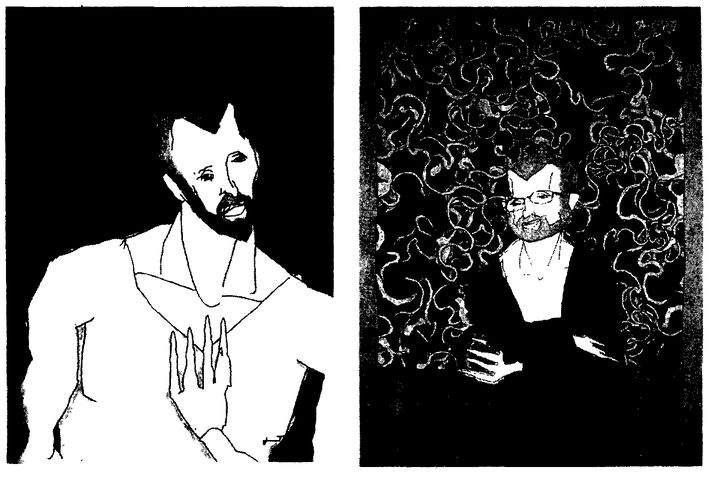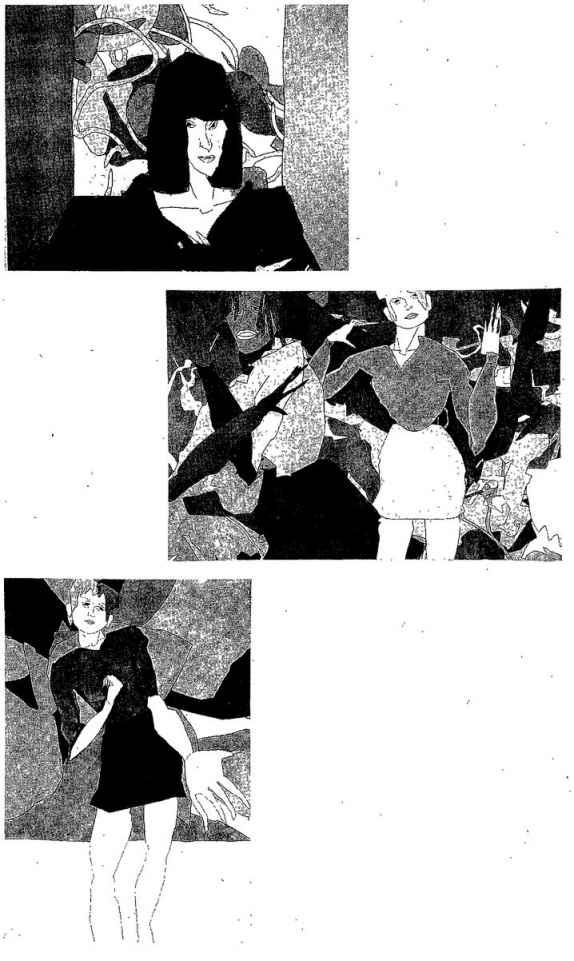The Age of Spiritual Machines: When Computers Exceed Human Intelligence (31 page)
Read The Age of Spiritual Machines: When Computers Exceed Human Intelligence Online
Authors: Ray Kurzweil
Tags: #Non-Fiction, #Fringe Science, #Amazon.com, #Retail, #Science

BOOK: The Age of Spiritual Machines: When Computers Exceed Human Intelligence
12.25Mb size Format: txt, pdf, ePub
Programs that write completely original works are particularly challenging because human readers are keenly aware of the myriad syntactic and semantic requirements for sensible written language. Musicians, cybernetic or otherwise, can get away with a bit more inconsistency than authors.
With that in mind, consider the following:
A Story of BetrayalDave Striver loved the university. He loved its ivy-covered clock towers, its ancient and sturdy brick, and its sun-splashed verdant greens and eager youth. He also loved the fact that the university is free of the stark unforgiving trials of the business world—only this isn’t a fact: Academia has its own tests, and some are as merciless as any in the marketplace. A prime example is the dissertation defense: To earn the Ph.D., to become a doctor, one must pass an oral examination on one’s dissertation. This was a test Professor Edward Hart enjoyed giving.
Dave wanted desperately to be a doctor. But he needed the signatures of three people on the first page of his dissertation, the priceless inscriptions which, together, would certify that he had passed his defense. One of the signatures had to come from Professor Hart, and Hart had often said—to others and to himself—that he was honored to help Dave secure his well-earned dream.
Well before the defense, Striver gave Hart a penultimate copy of his thesis. Hart read it and told Dave that it was absolutely first-rate, and that he would gladly sign it at the defense. They even shook hands in Hart’s book-lined office. Dave noticed that Hart’s eyes were bright and trustful, and his bearing paternal.
At the defense, Dave thought that he eloquently summarized chapter 3 of his dissertation. There were two questions, one from Professor Rogers and one from Dr. Meteer; Dave answered both, apparently to everyone’s satisfaction. There were no further objections.
Professor Rogers signed. He slid the tome to Meteer; she too signed, and then slid it in front of Hart. Hart didn’t move.
“Ed?” Rogers said.
Hart still sat motionless. Dave felt slightly dizzy.
“Edward, are you going to sign?”
Later, Hart sat alone in his office, in his big leather chair, saddened by Dave’s failure. He tried to think of ways he could help Dave achieve his dream.
Okay, that’s the end. Admittedly the story kind of peters out, ending with a whimper rather than a bang. Seattle writer and editor Susan Mulcahy called the story “amateurish,” criticizing the author’s grammar and word choice. But Mulcahy was nonetheless surprised and impressed when she learned the author was a computer. The program that wrote the story, named BRUTUS.1, was created by Selmer Bringsjord, Dave Ferucci, and a team of software engineers at Rensselaer Polytechnic Institute. Apparently, BRUTUS. 1 is an expert on betrayal, a concept that Bringsjord and Ferucci spent eight years painstakingly teaching the computer. The researchers acknowledge that their program needs to learn about other issues besides betrayal. “Interestingness really combines all of the emotions,” say Bringsjord and Ferucci, and that is something the cybernetic authors are not yet capable of achieving.
6
The Cybernetic Poet6
Another example of a computerized author is a computer program that I designed called Ray Kurzweil’s Cybernetic Poet (RKCP). RKCP is a computer-generated poetry system, which uses language-modeling techniques to automatically generate completely original poetry based on poems that it has “read.”
7
7
RKCP reads a selection of poems by a particular author or authors (preferably an extensive selection) and then creates a “language model” of that author’s work based on markov models, a mathematical cousin of neural nets. RKCP can then write original poems from that model. As I discussed earlier, RKCP uses a recursive poetry-generation algorithm to achieve the language style, rhythm patterns, and poem structure of the original authors whose poems were analyzed. There are also algorithms to maintain thematic consistency through the poem. The poems are in a similar style to the author(s) originally analyzed but are completely original new poetry. The system even has rules to discourage itself from plagiarizing.
You can download a free copy of RKCP at
www.kurzweiltech.com
.
www.kurzweiltech.com
.
Following is a small sampling of poems written by Ray Kurzweil’s Cybernetic Poet after it had “read” poems by several famous poets, as well as lesser-known contemporary poets.
Poems by Ray Kurzweil’s Cybernetic PoetPAGEA haiku written by Ray Kurzweil’s Cybernetic Poet after reading poems by Wendy DennisSashay down the page
through the lioness
nestled in my soul.IMAGINE NOW AND SINGA poem written by Ray Kurzweil’s Cybernetic Poet after reading poems by Wendy Dennis and Ray Kurzweil and love poems by various authorsImagine now and sing,
creating myths
forming jewels from the falling snow.SOULA haiku written by Ray Kurzweil’s Cybernetic Poet after reading poems by John Keats and Wendy DennisYou broke my soul
the juice of eternity,
the spirit of my lips.I THINK I’LL CRASHA poem written by Ray Kurzweil’s Cybernetic Poet after reading poems by Ray Kurzweil, Robert Frost, and Wendy DennisI think I’ll crash.
Just for myself with God
peace on a curious sound
for myself in my heart?
And life is weeping
From a bleeding heart
of boughs bending
such paths of them,
of boughs bending
such paths of breeze
knows we’ve been thereTHE STIFLING STUFFYA haiku written by Ray Kurzweil’s Cybernetic Poet after reading poems by Patricia Camarena Rose and Wendy DennisThe stifling stuffy
Catholic schoolroom,
where I cannot be real.WONDEREDA poem written by Ray Kurzweil’s Cybernetic Poet after reading poems by Dave Gitomertoday i wondered
if i mused
today
i
saw you
i learned
in awe and you
if i wondered
if i mused
today i had one wish
if i saw you
if i saw you
if had one wishMOON CHILDA haiku written by Ray Kurzweil’s Cybernetic Poet after reading poems by Kathleen Frances WheelerCrazy moon child
Hide from your coffin
To spite your doom.ANGELA poem written by Ray Kurzweil’s Cybernetic Poet after reading poems by Patricia Camarena Rose and Sue Klapes KellyBeams of the dawn at the angel
with a calm, silent sea
with a hundred times we write,
with a chance we can open up
a steady rhythm in his face
silent room
desolate beach,
Scattering remains of love.TOMCATA haiku written by Ray Kurzweil’s Cybernetic Poet after reading poems by Randi and Kathryn LynnAn old yellow tomcat
lies sleeping content,
he rumbles a heartLONG YEARS HAVE PASSEDA poem written by Ray Kurzweil’s Cybernetic Poet after reading poems by Randi and Kathryn LynnLong years have passed.
I think of goodbye.
Locked tight in the night
I think of passion;
Drawn to for blue, the night
During the page
My shattered pieces of life
watching the joy
shattered pieces of love
My shattered pieces of love
gone stale.SANDALSA haiku written by Ray Kurzweil’s Cybernetic Poet after reading poems by Kimberly McLauchlin and Ray KurzweilScattered sandals
a call back to myself,
so hollow I would echo.
The visual arts lie in between the musical arts and literary arts in terms of the impact of computers. A great deal of visual art is created using paint and illustrator programs, which can simulate the effects of conventional materials such as paint strokes as well as implement a wide range of techniques that could only be executed on a computer. Recently, computers have also taken over most video and film editing.
The Web is filled with the artistic musings of cybernetic artists. A popular technique is the evolutionary algorithm, which allows the computer to evolve a picture by redoing it hundreds or thousands of times. Humans would find this approach difficult—they would waste a lot of paint, for one thing. Mutator, the creation of sculptor William Latham and software engineer Stephen Todd at IBM in Winchester, England, uses the evolutionary approach, as does a program written by Karl Sims, an artist and scientist at Genetic Arts, in Cambridge, Massachusetts.
8
8
Probably the leading practitioner of computer-generated visual art is Harold Cohen. His computerized robot named Aaron has been evolving and creating drawings and paintings for twenty years. These works of visual art are completely original, created entirely by the computer, and rendered with real paint. Cohen has spent more than three decades endowing his program with a knowledge of many aspects of the artistic process, including composition, drawing, perspective, and color, as well as a variety of styles. While Cohen wrote the program, the pictures created are nonetheless always a surprise to him.
Cohen is frequently asked who should be given credit for the results of his enterprise, which have been displayed in museums around the world.
9
Cohen is happy to take the credit, and Aaron has not been programmed to complain. Cohen boasts that he will be the first artist in history who will be able to have a posthumous exhibition of completely original works.
10
Paintings by Aaron by Cohen9
Cohen is happy to take the credit, and Aaron has not been programmed to complain. Cohen boasts that he will be the first artist in history who will be able to have a posthumous exhibition of completely original works.
10
These five original paintings were painted by Aaron, a computerized robot built and programmed by Harold Cohen. These color paintings are reproduced here in black and white. You can see the color versions on this book’s web site, at
www.penguinputnam.com/kurzweil
.
11
www.penguinputnam.com/kurzweil
.
11


Other books
Private Practice by Samanthe Beck
Prairie Wife by Cheryl St.john
Duty and Devotion by Tere Michaels
The Atomic Weight of Secrets or The Arrival of the Mysterious Men in Black by Eden Unger Bowditch
Rachel in Love by Pat Murphy
Murder at the High School Reunion by Steve Demaree
Relief Map by Rosalie Knecht
Domme By Default by Tymber Dalton
Redemption Of The Sacred Land (Book 3) by Mark Tyson
The Returners by Washburn Jr, Thomas
